Evaluation of Nitrogen and Phosphorus Responses on Yield, Quality and Economic Advantage of Winter Wheat (Triticum aestivum, L.) under Four Different Agro-Climatic Zones in Afghanistan
Abstract
1. Introduction
2. Materials and Methods
2.1. Field Experiment
2.2. Meteorology Data
2.3. Statistical Analysis
3. Results
3.1. Agronomic Traits and Kernel Analyses
3.2. Partial Economic Analyses
4. Discussion
5. Conclusions
Supplementary Materials
Author Contributions
Funding
Data Availability Statement
Acknowledgments
Conflicts of Interest
References
- Ministry of Agriculture Irrigation and Livestock (MAIL), Food and Agriculture Organization (FAO). Wheat Sector Development Programme of Afghanistan; FAO: Rome, Italy, 2013; pp. 1–2. [Google Scholar]
- Halimi, G.H. Trade and agriculture policy options to improve the wheat subsector in Afghanistan. Ph.D. Thesis, Purdue University, West Lafayette, NI, USA, 2016. [Google Scholar]
- Chabot, P.; Dorosh, P.A. Wheat markets, food aid and food security in Afghanistan. Food Policy 2007, 32, 334–353. [Google Scholar] [CrossRef]
- FEWS NET. Food security outlook: Conflict and poor agricultural production expected to drive deteriorating food security in Afghanistan. Knoenam data hub. 2021. Available online: https://fews.net/central-asia/afghanistan/food-security-outlook/. (accessed on 12 September 2021).
- Ministry of Agriculture Irrigation and Livestock (MAIL), Food and Agriculture Organization (FAO). Agriculture and Food Production in Post-War Afghanistan; FAO: Rome, Italy, 2002. [Google Scholar]
- World Bank. Agricultural Sector Review Revitalizing Agriculture for Economic Growth, Job Creation and Food Security; World Bank: Washington, DC, USA, 2014; pp. 21–27. Available online: https://openknowledge.worldbank.org/handle/10986/21733 (accessed on 21 December 2022).
- Sharma, R. Sustainable Wheat and Maize Production in Afghanistan; Project report; International Maize and Wheat Improvement Center: Kabul, Afghanistan, 2019; pp. 21–22. Available online: https://www.aciar.gov.au/project/cim-2011-026 (accessed on 21 December 2022).
- Dreisigacker, S.; Sharma, R.K.; Huttner, E.; Karimov, A.; Obaidi, M.Q.; Singh, P.K.; Sansaloni, C.; Shrestha, R.; Sonder, K.; Braun, H.J. Tracking the adoption of bread wheat varieties in Afghanistan using DNA fingerprinting. Acta Sci. Agron. 2019, 20, 660. [Google Scholar] [CrossRef]
- Mussarat, M.; Shair, M.; Muhammad, D.; Mian, I.A.; Khan, S.; Adnan, M.; Fahad, S.; Dessoky, E.S.; el Sabagh, A.; Zia, A.; et al. Accentuating the role of nitrogen to phosphorus ratio on the growth and yield of wheat crop. Sustainability 2021, 13, 2253. [Google Scholar] [CrossRef]
- Maathuis, F.J. Physiological functions of mineral macronutrients. Curr. Opin. Plant Biol. 2009, 12, 250–258. [Google Scholar] [CrossRef] [PubMed]
- Cotrufo, M.F.; Wallenstein, M.D.; Boot, C.M.; Denef, K.; Paul, E. The microbial efficiency-matrix stabilization (MEMS) framework integrates plant litter decomposition with soil organic matter stabilization: Do labile plant inputs form stable soil organic matter? Glob. Change Biol. 2013, 19, 988–995. [Google Scholar] [CrossRef]
- Kallenbach, C.M.; Frey, S.D.; Grandy, A.S. Direct evidence for microbial-derived soil organic matter formation and its ecophysiological controls. Nat. Commun. 2013, 7, 13630. [Google Scholar] [CrossRef] [PubMed]
- Plaxton, W.C.; Tran, H.T. Metabolic adaptations of phosphate-starved plants. Plant Physiol. 2011, 156, 1006–1015. [Google Scholar] [CrossRef]
- Lindsay, W.L.; Vlek, P.L.; Chien, S.H. Phosphate minerals. Miner. Soil Environ. 1989, 1, 1089–1130. [Google Scholar]
- Sato, S.; Solomon, D.; Hyland, C.; Ketterings, Q.M.; Lehmann, J. Phosphorus speciation in manure and manure-amended soils using XANES spectroscopy. Environ. Sci. Technol. 2005, 39, 7485–7491. [Google Scholar] [CrossRef] [PubMed]
- Penn, C.; Camberato, J. A critical review on soil chemical processes that control how soil pH Affects phosphorus availability to plants. Agriculture 2019, 9, 120. [Google Scholar] [CrossRef]
- Devau, N.; Le Cadre, E.; Hinsinger, P.; Gérard, F. A mechanistic model for understanding root-induced chemical changes controlling phosphorus availability. Ann. Bot. 2010, 105, 1183–1197. [Google Scholar] [CrossRef] [PubMed]
- Güsewell, S. N:P ratios in terrestrial plants: Variation and functional significance. New Phytol. 2004, 164, 243–266. [Google Scholar] [CrossRef] [PubMed]
- Mandic, V.; Krnjaja, V.; Tomic, Z.; Bijelic, Z.; Simic, A.; Muslic, D. Nitrogen fertilizer influence on wheat yield and use efficiency under different environmental conditions. Chil. J. Agric. Res. 2015, 75, 92–97. [Google Scholar] [CrossRef]
- Ferrari, M.; Szareski, V.J.; Nardino, M.; de Pelegrin, A.J.; Carvalho, I.R.; de Souza, V.Q. Effects of sources and split application of nitrogen fertilizer on wheat genotypes performance. Aust. J. Crop Sci. 2016, 10, 1669–1674. [Google Scholar] [CrossRef]
- Barraclough, P.B.; Howarth, J.R.; Jones, J.; Lopez-Bellido, R.; Parmar, S.; Shepherd, C.E.; Hawkesford, M.J. Nitrogen efficiency of wheat: Genotypic and environmental variation and prospects for improvement. Eur. J. Agron. 2010, 33, 1–11. [Google Scholar] [CrossRef]
- Majeed, M.A.; Ahmad, R.; Tahir, M.; Tanveer, A.; Ahmad, M. Effect of phosphorus fertilizer sources and rates on growth and yield of wheat (Triticum aestivum L.). Asian J. Agric. Biol. 2014, 2, 14–19. [Google Scholar]
- Islam, S.; Ullah, S.; Anjum, M.; Ali, N.; Ahmad, B.; Ahmad, S. Impact of various levels of phosphorus on wheat (CV. PIRSABAK-2013). Int. J. Environ. Sci. Nat. Res. 2017, 6, 106–111. [Google Scholar]
- Dargie, S.; Girma, T.; Chibsa, T.; Kassa, S.; Boke, S.; Abera, A.; Haileselassie, B.; Addisie, S.; Amsalu, S.; Haileselassie, M.; et al. Balanced fertilization increases wheat yield response on different soils and agroecological zones in Ethiopia. Exp. Agric. 2022, 58, E23. [Google Scholar] [CrossRef]
- Sileshi, G. Dose-response models to guide site-specific nutrient management and lessons for fertiliser trial design in sub-Saharan Africa. Exp. Agric. 2022, 58, E2. [Google Scholar] [CrossRef]
- Agha, J.; Dass, A.; Rajanna, G.A.; Sarkar, S.K.; Rana, K.S. Influence of varying nitrogen levels on performance of wheat (Triticum aestivum L.) under semi-arid hot climate of Kandahar, Afghanistan. Ann. Agric. Res. 2016, 37, 347–352. [Google Scholar]
- Gyeltshen, K.; Sharma, S. Integrated Plant Nutrition System Modules for Major Crops and Cropping Systems in South Asia; SAARC Agriculture Centre, SAARC: Dhaka, Bangladesh, 2019; p. 184. [Google Scholar]
- Obaid, H.; khalili, A.; Sharifi, S.; Dhar, S. Effect of different levels of phosphorus on growth and yield of wheat (Triticum aestivum, L.) in Kandahar region of Afghanistan. Ann. Agric. Res. 2019, 40, 1–5. [Google Scholar]
- Soofizada, Q.; Pescatore, A.; Guerrini, L.; Fabbri, C.; Mancini, M.; Orlandini, S.; Napoli, M. Effects of nitrogen plus sulfur fertilization and seeding density on yield, rheological parameters, and asparagine content in old varieties of common wheat (Triticum aestivum L.). Agronomy 2022, 12, 351. [Google Scholar] [CrossRef]
- International Maize and Wheat Improvement Center (CIMMYT). From Agronomic Data to Farmer Recommendations; International Maize and Wheat Improvement Center: El Batan, Mexico, 1988; pp. 9–28. Available online: https://repository.cimmyt.org/xmlui/bitstream/handle/10883/830/13803.pdf (accessed on 21 December 2022).
- Food Agricultural Organization (FAO). Agricultural Agro-Ecological Zoning of Afghanistan; FAO: Rome, Italy, 2019. [Google Scholar]
- Salazar-Gutierrez, M.R.; Johnson, J.; Chaves-Cordoba, B.; Hoogenboom, G. Relationship of base temperature to develop-ment of winter wheat. Int. J. Plant Prod. 2013, 7, 741–762. [Google Scholar]
- Grassi, C.; Cecchi, S.; Baldi, A.; Zanchi, C.A.; Orlandini, S.; Pardini, A.; Napoli, M. Crop suitability assessment in remedia-tion of Zn contaminated soil. Chemosphere 2020, 246, 125706. [Google Scholar] [CrossRef]
- Li, Q.Y.; Yin, J.; Liu, W.D.; Zhou, S.M.; Li, L.; Niu, J.S.; Niu, H. bin, Ma, Y. Determination of optimum Growing Degree-Days (GDD) range before winter for wheat cultivars with different growth characteristics in North China Plain. J. Integr. Agric. 2012, 11, 405–415. [Google Scholar] [CrossRef]
- Fabbri, C.; Mancini, M.; Dalla Marta, A.; Orlandini, S.; Napoli, M. Integrating satellite data with a Nitrogen Nutrition Curve for precision topdress fertilization of durum wheat. Eur. J. Agron. 2020, 120, 126148. [Google Scholar] [CrossRef]
- Saiyed, I.M.; Bullock, P.R.; Sapirstein, H.D.; Finlay, G.J.; Jarvis, C.K. Thermal time models for estimating wheat phenologi-cal development and weather-based relationships to wheat quality. Can. J. Plant Sci. 2009, 89, 429–439. [Google Scholar] [CrossRef]
- Hashimi, R.; Matsuura, E.; Komatsuzaki, M. Effects of cultivating rice and wheat with and without organic fertilizer application on greenhouse gas emissions and soil quality in Khost, Afghanistan. Sustainability 2020, 12, 6508. [Google Scholar] [CrossRef]
- Ayubi, A.G. Principle of Irrigation and Drainage; Aazem Publication: Kabul, Afghanistan, 2016; Volume 31, p. 174. [Google Scholar]
- Sameen, A.Q.; Zaghard, M.A. Soil Chemistry and Plant Nutrients; World Bank: Kabul, Afghanistan, 2008; pp. 58–295. [Google Scholar]
- Zaveri, E.; Lobell, D. The role of irrigation in changing wheat yields and heat sensitivity in India. Nat. Commun. 2019, 10, 4144. [Google Scholar] [CrossRef]
- Rout, B. How the Water Flows: A Typology of Irrigation Systems in Afghanistan; Issue Paper Series: Water Management, Livestock and the Opium Economy; Afghanistan Research and Evaluation Unit: Kabul, Afghanistan, 2008; p. 57. [Google Scholar]
- Kawasaki, S.; Watanabe, F.; Suzuki, S.; Nishimaki, R.; Takahashi, S. Current situation and issues on agriculture of Afghanistan. J. Arid. Land Stud. 2012, 348, 345–348. [Google Scholar]
- Kostíc, M.M.; Tagarakis, A.C.; Ljubičíc, N.; Blagojevíc, D.; Radulovíc, M.; Ivoševíc, B.; Rakíc, D. The effect of N fertilizer application timing on wheat yield on chernozem soil. Agronomy 2021, 11, 1413. [Google Scholar] [CrossRef]
- Haile, D.; Nigussie, D.; Ayan, A. Nitrogen use efficiency of bread wheat: Effects of nitrogen rate and time of application. J. Soil Sci. Plant Nutr. 2012, 12, 389–409. [Google Scholar]
- Guarda, G.; Padovan, S.; Delogu, G. Grain yield, nitrogen-use efficiency and baking quality of old and modern Italian bread-wheat cultivars grown at different nitrogen levels. Eur. J. Agron. 2004, 21, 181–192. [Google Scholar] [CrossRef]
- Mansoor, H.A.; Ndondi, R.V.; Tanner, D.O.; Ndakidemi, P.; Ngatokewa, R.T. On-farm evaluation of the response of four bread wheat varieties to nitrogen fertilizer in Karatu district in northern Tanzania. In The Eleventh Regional Wheat Workshop for Eastern, Central and Southern Africa; CIMMYT: Addis Ababa, Ethiopia, 2000; pp. 352–359. ISBN 92-9146-087-7. [Google Scholar]
- Tao, Y.; Qin, Z.; Qi, W.; Xiao, W.; Jian, C.; Mei, H.; Dong, J. effects of nitrogen fertilizer on quality characteristics of wheat with the absence of different individual high-molecular-weight glutenin subunits (HMW-GSs). Int. J. Mol. Sci. 2022, 4, 23. [Google Scholar]
- Cai, A. Xu, M.; Wang, B.; Zhang, W.; Liang, G.; Hou, E.; Luo, Y. Manure acts as a better fertilizer for increasing crop yields than synthetic fertilizer does by improving soil fertility. Soil Tillage Res. 2019, 189, 168–175. [Google Scholar] [CrossRef]
- Food and Agriculture Organization (FAO). Soil Fertility and Fertilizer Use; Report of the Government of Afghanistan; Government of Afghanistan: Kabul, Afghanistan, 1971. [Google Scholar]
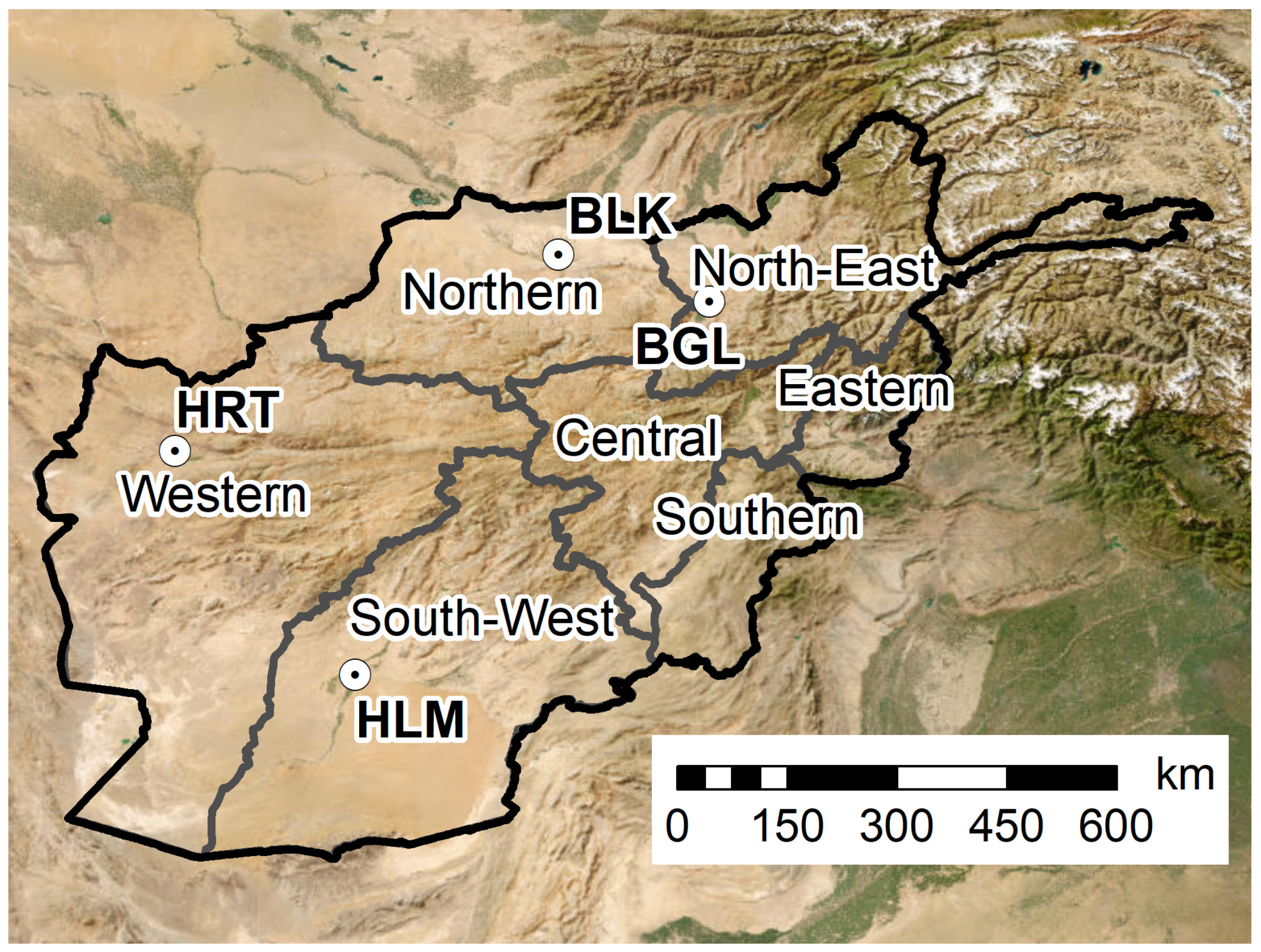
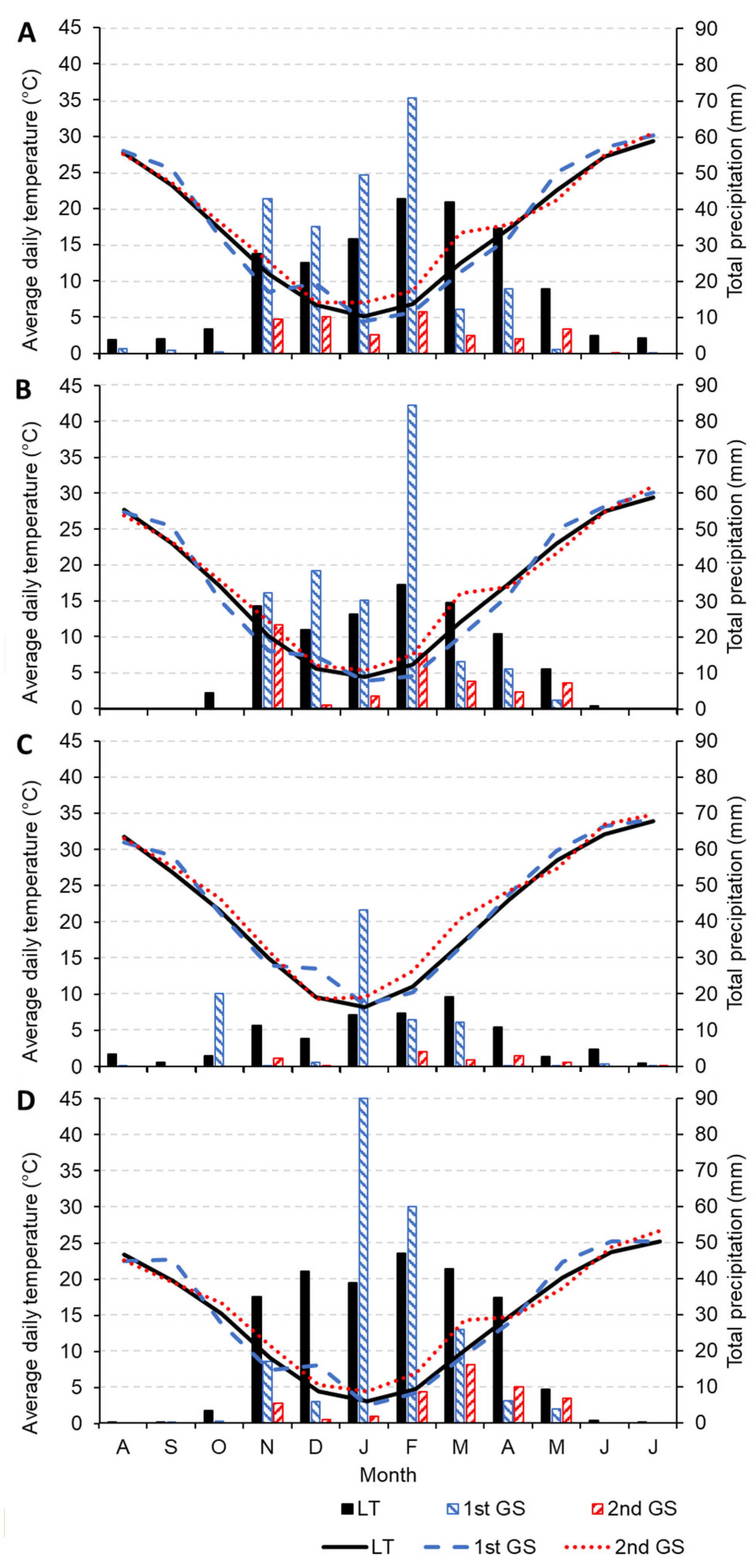
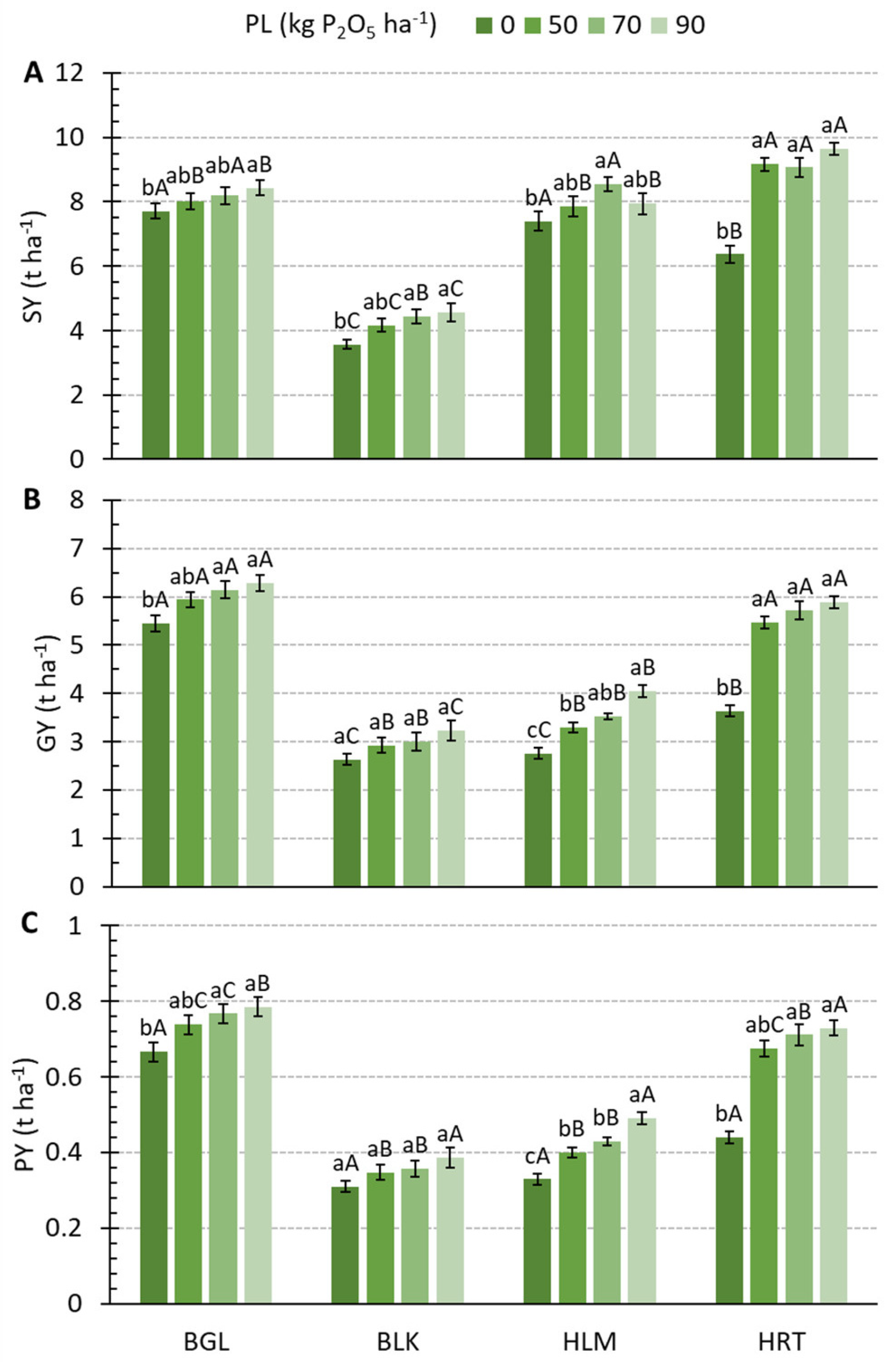
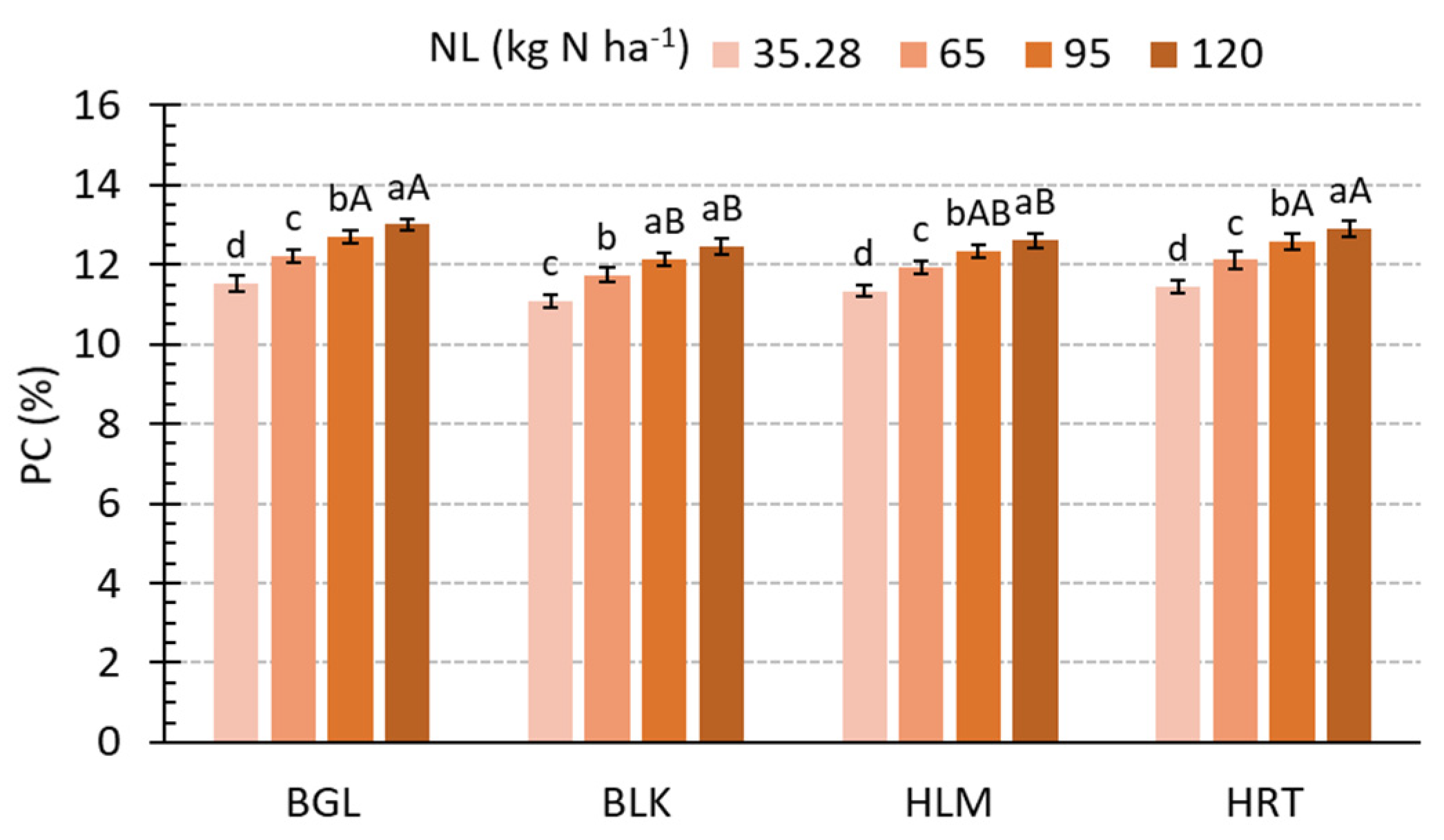

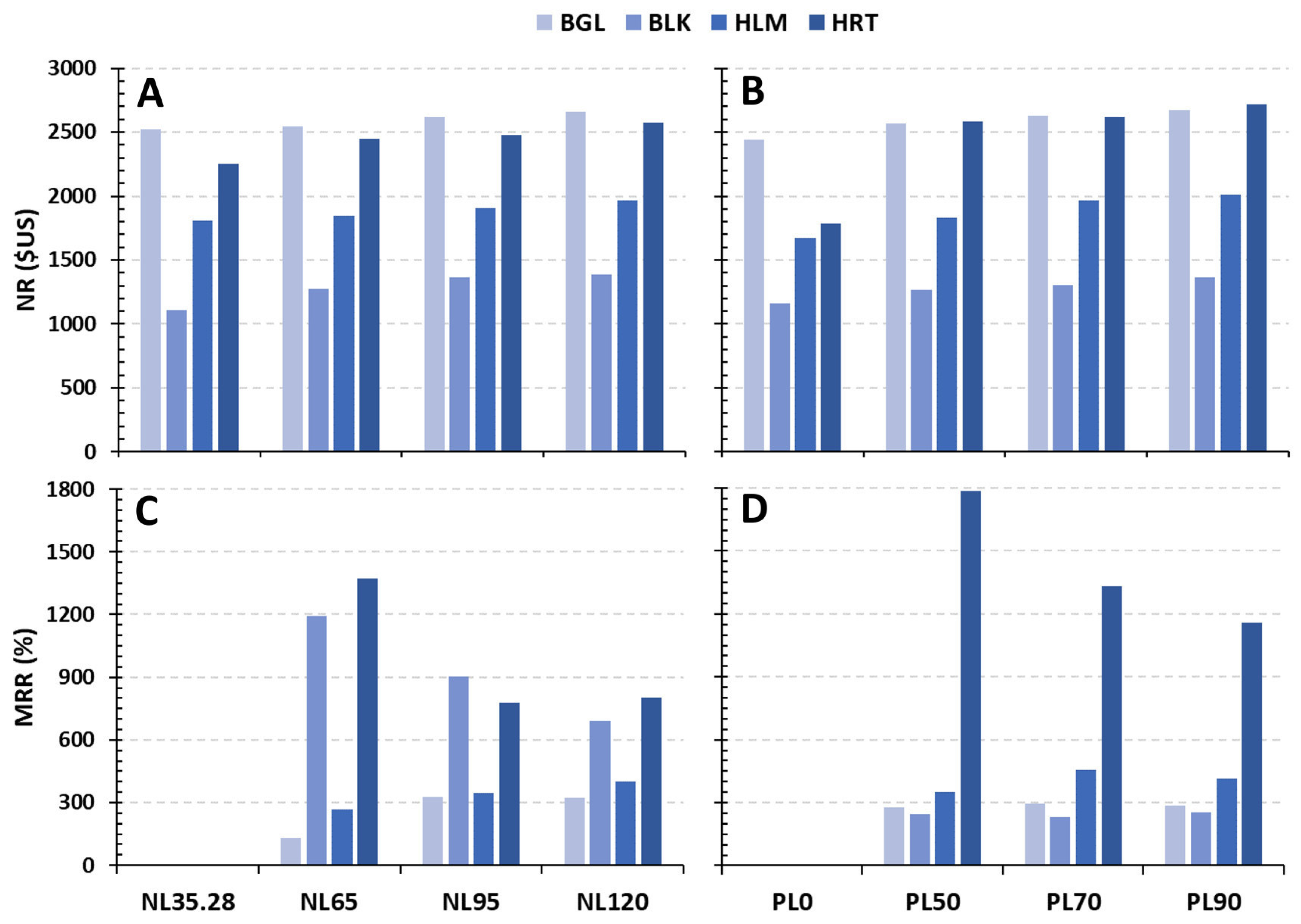
| Characteristic | Locations | |||
|---|---|---|---|---|
| Baghlan | Balkh | Helmand | Herat | |
| Location acronym | BGL | BLK | HLM | HRT |
| Research station name | Poza Eshan | Dehdadi | Bolan | Urdokhan |
| Latitude (N) | 36°09′ N | 36°65′ N | 31°65′ N | 34°31′ N |
| Longitude (m) | 68°64′ E | 66°95′ E | 66°96′ E | 62°27′ E |
| Altitude (m) | 510 | 378 | 787 | 927 |
| ACZ | ACZ-NE | ACZ-N | ACZ-SW | ACZ-W |
| pH | 7.50 | 8.12 | 7.91 | 7.60 |
| Organic matter (%) | 1.50 | 1.01 | 0.63 | 0.82 |
| Available P (mg P kg−1) | 8.50 | 5.41 | 6.12 | 7.54 |
| Available K (mg K kg−1) | 120 | 117 | 107 | 115 |
| Total N (g N kg−1) | 1.00 | 0.61 | 0.70 | 0.85 |
| Sand (%) | 36.8 | 18.9 | 24.7 | 63.8 |
| Silt (%) | 37.6 | 52.3 | 53.2 | 26.0 |
| Clay (%) | 25.6 | 28.8 | 22.1 | 10.2 |
| Soil texture | Loam | Silty loam | Silty loam | Sandy loam |
| Variation Source | DF | TN (N) | PH (cm) | SY (t ha−1) | GY (t ha−1) | TKW (g) | PC (%) | PY (t ha−1) | |||||||
|---|---|---|---|---|---|---|---|---|---|---|---|---|---|---|---|
| F | Sig | F | Sig | F | Sig | F | Sig | F | Sig | F | Sig | F | Sig | ||
| GS | 1 | 3.94 | * | 41.25 | *** | 0.25 | ns | 138.85 | *** | 45.01 | *** | 364.18 | *** | 103.60 | *** |
| L | 3 | 338.07 | *** | 331.19 | *** | 268.57 | *** | 803.29 | *** | 332.71 | *** | 546.52 | *** | 819.50 | *** |
| NL | 3 | 0.98 | ns | 6.79 | *** | 0.81 | ns | 55.76 | *** | 11.61 | *** | 3901.40 | *** | 124.67 | *** |
| PL | 3 | 6.78 | *** | 65.37 | *** | 26.70 | *** | 113.47 | *** | 11.25 | *** | 135.53 | *** | 118.40 | *** |
| GSxL | 3 | 130.04 | *** | 47.15 | *** | 12.49 | *** | 12.53 | *** | 55.14 | *** | 42.07 | *** | 52.86 | *** |
| GSxNL | 3 | 0.99 | ns | 1.25 | ns | 0.16 | ns | 0.51 | ns | 7.56 | *** | 0.25 | ns | 2.53 | ns |
| LxNL | 9 | 0.62 | ns | 3.33 | *** | 1.78 | ns | 0.95 | ns | 8.19 | *** | 5.15 | *** | 2.71 | ** |
| GSxPL | 3 | 1.07 | ns | 1.8 | ns | 0.40 | ns | 1.77 | ns | 2.46 | ns | 1.45 | ns | 1.72 | ns |
| LxPL | 9 | 1.21 | ns | 9.94 | *** | 5.94 | *** | 13.86 | *** | 2.77 | ** | 3.47 | *** | 13.66 | *** |
| NLxPL | 9 | 0.42 | ns | 1.06 | ns | 0.54 | ns | 0.56 | ns | 3.08 | ** | 0.78 | ns | 0.28 | ns |
| GSxLxNL | 9 | 0.87 | ns | 1.34 | ns | 0.94 | ns | 0.91 | ns | 1.55 | ns | 1.97 | * | 1.27 | ns |
| GSxLxPL | 9 | 0.86 | ns | 3.35 | *** | 3.09 | ** | 3.74 | *** | 2.03 | * | 1.69 | ns | 3.81 | *** |
| GSxNLxPL | 9 | 1.00 | ns | 0.46 | ns | 1.06 | ns | 0.42 | ns | 2.38 | * | 0.23 | ns | 0.47 | ns |
| LxNLxPL | 27 | 1.08 | ns | 1.13 | ns | 0.96 | ns | 0.50 | ns | 2.26 | ** | 0.91 | ns | 0.55 | ns |
| GSxLxNLxPL | 27 | 0.62 | ns | 0.61 | ns | 0.53 | ns | 0.51 | ns | 1.88 | ** | 0.92 | ns | 0.51 | ns |
| Residues | 256 | ||||||||||||||
| Variation Source | Obs. (N) | TN (N) | PH (cm) | SY (t ha−1) | GY (t ha−1) | TKW (g) | PC (%) | PY (t ha−1) | |
|---|---|---|---|---|---|---|---|---|---|
| NL (kg N ha−1) | 35.28 | 96 | 5.14 (0.21) | 91.98 (0.87) b | 7.06 (0.24) | 3.89 (0.14) d | 36.94 (0.46) bc | 11.34 (0.02) d | 0.44 (0.02) c |
| 65 | 96 | 5.30 (0.22) | 93.70 (0.76) ab | 7.18 (0.24) | 4.28 (0.15) c | 36.77 (0.45) c | 12.00 (0.03) c | 0.52 (0.02) b | |
| 95 | 96 | 5.36 (0.22) | 93.54 (0.78) ab | 7.21 (0.23) | 4.56 (0.15) b | 37.83 (0.61) ab | 12.43 (0.03) b | 0.57 (0.02) ab | |
| 120 | 96 | 5.19 (0.21) | 94.16 (0.80) a | 7.33 (0.22) | 4.76 (0.16) a | 38.60 (0.64) a | 12.74 (0.03) a | 0.61 (0.02) a | |
| PL (kg P2O5 ha−1) | 0 | 96 | 4.91 (0.21) b | 89.46 (0.86) c | 6.26 (0.21) b | 3.62 (0.13) d | 36.35 (0.50) b | 11.96 (0.06) b | 0.44 (0.02) b |
| 50 | 96 | 5.16 (0.21) ab | 92.81 (0.81) b | 7.30 (0.23) a | 4.41 (0.15) c | 37.84 (0.53) a | 12.16 (0.06) a | 0.54 (0.02) a | |
| 70 | 96 | 5.46 (0.23) a | 94.94 (0.67) a | 7.56 (0.23) a | 4.60 (0.16) b | 37.64 (0.56) a | 12.20 (0.06) a | 0.57 (0.02) a | |
| 90 | 96 | 5.44 (0.22) a | 96.17 (0.71) a | 7.64 (0.24) a | 4.86 (0.15) a | 38.31 (0.59) a | 12.20 (0.06) a | 0.60 (0.02) a | |
| L | BGL | 96 | 3.63 (0.09) c | 95.38 (0.55) b | 8.09 (0.13) b | 5.95 (0.09) a | 32.72 (0.24) c | 12.36 (0.06) a | 0.74 (0.01) a |
| BLK | 96 | 4.94 (0.18) b | 86.92 (0.48) d | 4.18 (0.12) c | 2.95 (0.09) d | 41.68 (0.45) a | 11.85 (0.06) b | 0.35 (0.01) d | |
| HLM | 96 | 4.54 (0.13) b | 89.38 (0.76) c | 7.94 (0.16) b | 3.41 (0.07) c | 41.16 (0.49) a | 12.05 (0.05) b | 0.41 (0.01) c | |
| HRT | 96 | 7.87 (0.15) a | 101.71 (0.36) a | 8.56 (0.18) a | 5.18 (0.12) b | 34.59 (0.26) b | 12.26 (0.06) a | 0.64 (0.02) b | |
| GS | 1st GS | 192 | 5.34 (0.18) a | 92.18 (0.53) b | 7.16 (0.15) | 4.67 (0.11) a | 38.37 (0.47) a | 12.04 (0.04) b | 0.57 (0.01) a |
| 2nd GS | 192 | 5.15 (0.12) b | 94.51 (0.60) a | 7.22 (0.18) | 4.07 (0.11) b | 36.70 (0.28) b | 12.22 (0.04) a | 0.50 (0.01) b | |
| pH | OM | Av_P | Av_K | Tot_N | GDD_TGf | P_TGf | NL | PL | GY | SY | PC | PY | |
|---|---|---|---|---|---|---|---|---|---|---|---|---|---|
| (%) | (mg P2O5 kg−1) | (kg K2O ha−1) | (kg N ha−1) | (°C) | (mm) | (kg ha−1) | (kg ha−1) | (t ha−1) | (t ha−1) | (%) | (t ha−1) | ||
| pH | 1 *** | 0.48 *** | −0.99 *** | −0.37 *** | −0.97 *** | 0.35 *** | −0.38 *** | 0 ns | 0 ns | −0.79 *** | −0.64 *** | −0.33 *** | −0.78 *** |
| OM (%) | 1 *** | 0.61 *** | 0.88 *** | 0.65 *** | −0.33 *** | 0.25 *** | 0 ns | 0 ns | 0.5 *** | −0.04 ns | 0.16 ** | 0.49 *** | |
| Av_P (mg kg−1) | 1 *** | 0.49 *** | 1 *** | −0.35 *** | 0.37 *** | 0 ns | 0 ns | 0.8 *** | 0.57 *** | 0.33 *** | 0.79 *** | ||
| Av_K (kg ha−1) | 1 *** | 0.49 *** | −0.7 *** | 0.58 *** | 0 ns | 0 ns | 0.43 *** | −0.17 ** | 0.11 ns | 0.42 *** | |||
| Tot_N (kg ha−1) | 1 *** | −0.3 *** | 0.32 *** | 0 ns | 0 ns | 0.8 *** | 0.55 *** | 0.33 *** | 0.78 *** | ||||
| GDD_TGf (°C) | 1 *** | −0.95 *** | 0 ns | 0 ns | −0.41 *** | 0.04 ns | −0.06 ns | −0.39 *** | |||||
| P_TGf (mm) | 1 *** | 0 ns | 0 ns | 0.48 *** | 0.02 ns | 0.06 ns | 0.46 *** | ||||||
| NL (kg ha−1) | 1 *** | 0 ns | 0.21 *** | 0.04 ns | 0.88 *** | 0.31 *** | |||||||
| PL (kg ha−1) | 1 *** | 0.3 *** | 0.24 *** | 0.16 ** | 0.3 *** | ||||||||
| GY (t ha−1) | 1 *** | 0.59 *** | 0.51 *** | 0.99 *** | |||||||||
| SY (t ha−1) | 1 *** | 0.3 *** | 0.58 *** | ||||||||||
| PC (%) | 1 *** | 0.6 *** | |||||||||||
| PY (t ha−1) | 1 *** |
Disclaimer/Publisher’s Note: The statements, opinions and data contained in all publications are solely those of the individual author(s) and contributor(s) and not of MDPI and/or the editor(s). MDPI and/or the editor(s) disclaim responsibility for any injury to people or property resulting from any ideas, methods, instructions or products referred to in the content. |
© 2023 by the authors. Licensee MDPI, Basel, Switzerland. This article is an open access article distributed under the terms and conditions of the Creative Commons Attribution (CC BY) license (https://creativecommons.org/licenses/by/4.0/).
Share and Cite
Soofizada, Q.; Pescatore, A.; Atefi, R.; Grassi, C.; Orlandini, S.; Napoli, M. Evaluation of Nitrogen and Phosphorus Responses on Yield, Quality and Economic Advantage of Winter Wheat (Triticum aestivum, L.) under Four Different Agro-Climatic Zones in Afghanistan. Agronomy 2023, 13, 345. https://doi.org/10.3390/agronomy13020345
Soofizada Q, Pescatore A, Atefi R, Grassi C, Orlandini S, Napoli M. Evaluation of Nitrogen and Phosphorus Responses on Yield, Quality and Economic Advantage of Winter Wheat (Triticum aestivum, L.) under Four Different Agro-Climatic Zones in Afghanistan. Agronomy. 2023; 13(2):345. https://doi.org/10.3390/agronomy13020345
Chicago/Turabian StyleSoofizada, Qudratullah, Antonio Pescatore, Rahmatullah Atefi, Chiara Grassi, Simone Orlandini, and Marco Napoli. 2023. "Evaluation of Nitrogen and Phosphorus Responses on Yield, Quality and Economic Advantage of Winter Wheat (Triticum aestivum, L.) under Four Different Agro-Climatic Zones in Afghanistan" Agronomy 13, no. 2: 345. https://doi.org/10.3390/agronomy13020345
APA StyleSoofizada, Q., Pescatore, A., Atefi, R., Grassi, C., Orlandini, S., & Napoli, M. (2023). Evaluation of Nitrogen and Phosphorus Responses on Yield, Quality and Economic Advantage of Winter Wheat (Triticum aestivum, L.) under Four Different Agro-Climatic Zones in Afghanistan. Agronomy, 13(2), 345. https://doi.org/10.3390/agronomy13020345










